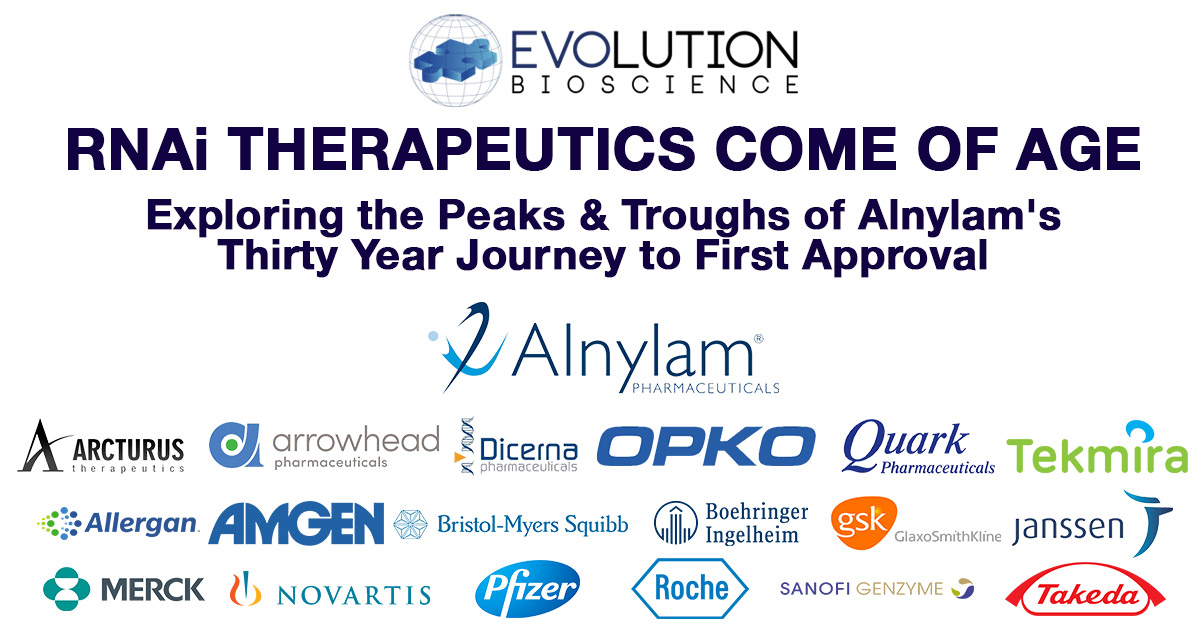
In August 2018, the FDA & European Commission announced the approval of Alnylam Pharmaceutical’s ONPATTRO, a first-of-its-kind RNA interference (RNAi) therapeutic. Evolution Bioscience’s latest timeline visualisation outlines the key events in the development and commercialisation of RNAi therapeutics, from Andrew Fire & Craig Mello’s initial discovery in 1998 through to Arrowhead and Johnson & Johnson’s $3.7B deal in October 2018.
What is RNAi?
RNA interference (RNAi) can be defined as a biological process in which double-stranded RNA molecules prevent the expression of disease-causing genes by enabling the destruction of their messenger RNAs (mRNAs), a consequence of which is the loss of protein expression. The concept offers an elegant mechanism of action to treat rare diseases, chronic liver diseases, cancer, cardiovascular disease and viral infectious diseases.
A Rocky Road to First Approval
The road to the first ever approval, Alnylam‘s ONPATTRO for the treatment of polyneuropathy of hereditary transthyretin-mediated (hATTR) amyloidosis in adults, has been a rocky one. This is due to a combination of foreseen and unforeseen development challenges largely centred around targeting, off-target effects, toxicology, delivery and formulation. Additional commercial challenges have arisen with litigation being a significant complicating factor along with the loss of big pharma interest at key stages.
The following timeline provides an overview of the last 30 years of RNAi research, development and commercialisation, including Alnylam and other key developers:

Other Notable RNAi Players
There are other notable players currently at preclinical and early clinical stages which utilise alternative approaches to trigger the RNA Induced Silencing Complex (RISC) response. This differentiates RNAi from other forms of RNA-based therapeutics, such as those of Ionis Pharma and Santaris (Roche), which involve antisense blockade by targeting mRNA but not inducing the RISC response. Companies involved include:
| Company | Focus | Commentary |
|---|---|---|
 | Head and neck squamous cell carcinoma (HNSCC), Oculopharyngeal muscular dystrophy (OPMD), hepatitis B (HBV), wet age-related macular degeneration (AMD). | DNA directed RNAi (ddRNAi) approach relies on the use of introducing DNA templates to utilize the cells’ endogenous transcriptional machinery to produce short hairpin RNAs (shRNAs) that are then processed by the endogenous RNAi machinery into siRNAs. |
 | Melanoma, Ovarian Cancer, Head & Neck Cancer. | Co-founded by Craig Mello, proprietary self-delivering RNAi (sd-rxRNA®) therapeutic platform, process involves ex-vivo treatment of the immune cells with oligonucleotides inhibiting expression of immune checkpoint genes. |
 | Pancreatic cancer, prostate cancer and certain brain cancers. | LODER™ (Local Drug EluteR) is the first cancer drug delivery platform to enable insertion of the RNAi therapeutic pharmaceuticals directly into the core of solid tumors for extended periods of time of a few months or more. |
Conclusions
30 years on from the Andrews & Mello discovery, the first RNAi treatment has finally been approved, and the promise of RNAi is nearing the forefront of the clinical development agenda. The clinical opportunities are significant: of approximately 20,000 genes in the human genome, 600-1,500 are considered “druggable,” as defined as those that can be targeted effectively with existing drug approaches such as small molecules or other inhibitors and proteins such as monoclonal antibodies. The discovery of RNAi has potentially made every gene a druggable target.
Transcriptomics, a key source of understanding gene expression in detail, is entering a new phase with the development and introduction of high-throughput next-generation sequencing (NGS) technologies pioneered by Illumina, Thermo Fisher and others. The consequence of these developments will be the discovery of a host of potential novel targets for RNAi therapeutics.
Follow Evolution Bioscience on LinkedIn to keep up-to-date with news and trends from the biotechnology, biopharmaceutical, medical device and related industries.

























